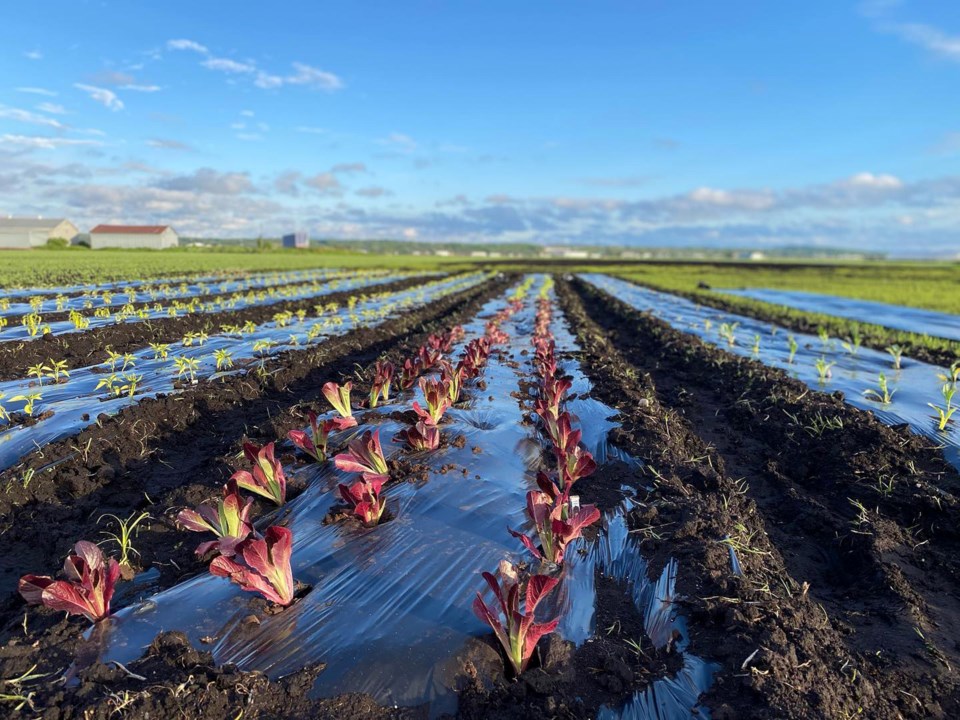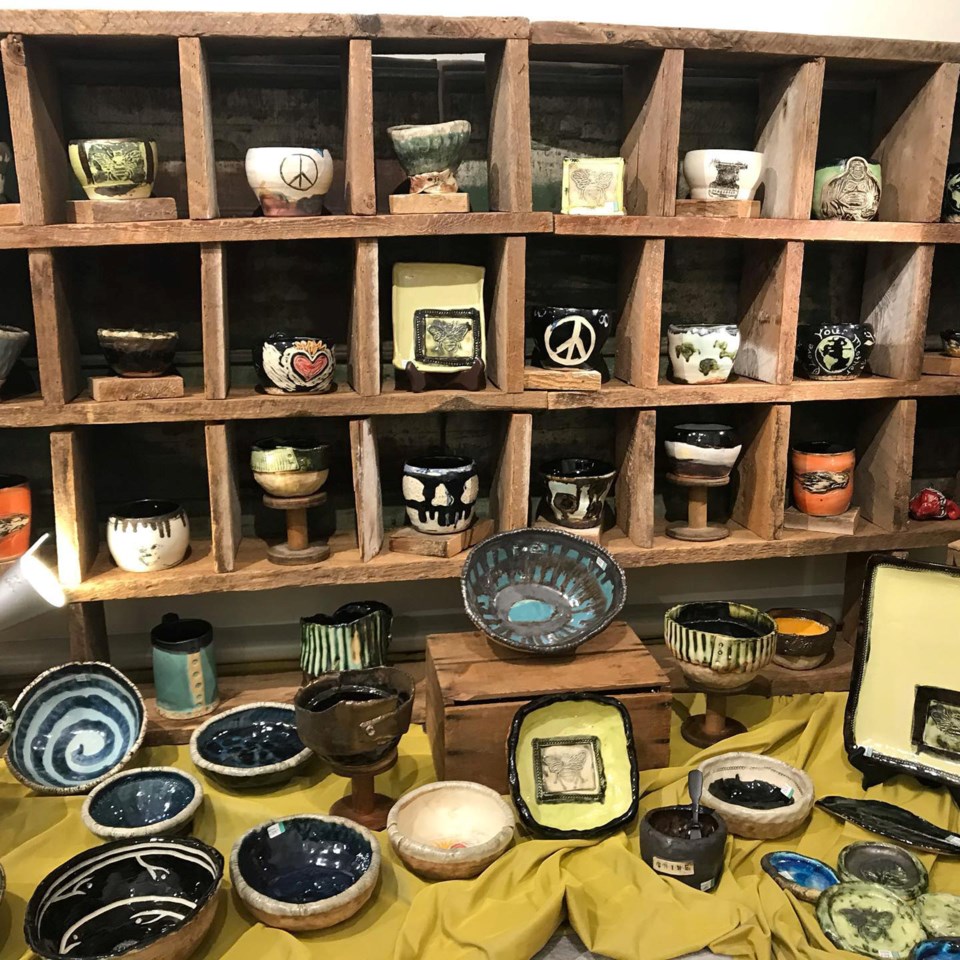There are few people who seem like they have truly found “pure harmony,” and fewer still who are able to share that feeling, but Linda Szoldatits has found a down-to-earth method.
The Bradford farmer and artist is known for both her harvest boxes from Seed to Feed Co, full of natural vegetables, and her rustic artwork, including pottery and pottery workshops.
Born and raised in Bradford, Szoldatits works the same family farm where she was raised by her mother and father, and grows and sells the same heirloom peppers, tomatoes, kale, zucchini and eggplants that her father brought to Canada after growing up on a farm in Hungary.
“I have some tomato seeds that somebody saved since like 1846,” Szoldatits said, noting the purple colour.
The tradition of unmodified plants speaks to Szoldatits because people had to care about and appreciate the seeds year after year for them to continue being used.
She also grows garlic and specialty herbs that can be used in teas, with all plants started in the greenhouse and then moved to pots before her annual plant sale right before the Victoria Day weekend.
Whatever doesn’t get sold, she plants in the fields.
While the farm has two fields about 7.5 acres each, some is rented out and Szoldatits uses about half for small-batch horticulture.
“Small batch is something I’ve transitioned the farm into, because I just want everything to be natural. I want to give people good food and that’s the best way that I know how to do it,” she said.
That means the farm doesn’t spray any of the plants, which leads to a lot of extra labour.
Not only is everything planted by hand, but it also needs to be tended in the greenhouse longer before being transplanted, and even with ground cover, there’s still weeding to be done and pests with which to deal.
Despite all the planning and effort she puts in to get the best yield while keeping things natural, Szoldatits acknowledges farming always comes with risk.
“It’s like calculated consideration,” she said.
Still, Szoldatits wouldn’t have it any other way.

“I love this farm. I keep everything very simple and humble, but I think that’s part of the key to farming the way that we do it,” she said.
Part of her aversion to spraying the fields is Szoldatits’ desire to cohabitate with nature, including the bees living in the six beehives on the farm, which also features a section of wildflower field where the bees can enjoy sunflowers, echinacea, lavender, bee balm and clover, and she also lets some areas naturalize and fill with goldenrod.
In the springtime, she grows microgreens inside the greenhouse, letting them bloom so the bees can come in and eat from those as well.
“I have flowers in the greenhouse that my dad originally planted in there. They drop seed and fill the greenhouse and the bees love them, so I leave them,” she said.
In exchange, the bees pollinate the plants and provide sweet golden honey for the farm.
“We literally take it from the hive into the jars,” Szoldatits said. “Honey’s the only food that doesn’t go bad. It’s been found in tombs in Egypt, and it was like liquid gold to them and it’s still liquid gold.”
Her consideration for harmony with nature extends beyond just her planting methods and beekeeping though, and includes caring for two special chickens in the greenhouse all spring, summer and fall after they were rejected by their siblings.
“There is a pecking order, and they almost died,” Szoldatits said, explaining how she nursed them back to health by feeding them organic hemp hearts and greenhouse greens. “They went from almost dying to you wouldn’t recognize them now.”
With winter approaching, Szoldatits is preparing to move them to a little barn she built for them, and in the spring, she’s planning for two older sheep to come live out the rest of their days on the farm.
To help the plants in the greenhouse grow, Szoldatits plays acoustic music for them, and unlike most people, doesn’t mind when the rabbits make their way inside.
“My theory on rabbits is that I put plenty, so you can have some, and we have some,” she said, noting they’ve never taken out an entire row of something or caused serious damage.
Sometimes things will get nibbled here and there, but Szoldatits understands the rabbits need to live too.
“Everything here gets treated with respect and I kind of feel like that’s the same tradition that my parents brought us up with farming,” she said. “Everything is about respect and appreciation and tradition.”
That appreciation and respect for others influences her art as well.
Szoldatits graduated from the Ontario College of Art and Design (OCAD) in 1995 before working for a Toronto photographer, then starting her own studio in Ottawa and designing home interiors.
But she was eventually drawn back to the farm where she has raised her three children, aged 21, 18 and 17.
She started teaching pottery nine years ago, a medium in which she’s been working for more than 30 years.
“When I’m teaching pottery, it’s no different than how I grew up; I’m playing in the dirt. I’m really just showing people how to be a kid,” she said.
Recently, she finished converting a barn into her studio and began offering lessons, but also teaches adult pottery fundamentals classes at Pine Tree Potters’ Guild in Aurora.
While the classes in Aurora usually see her teaching 10 to 12 students at a time, in her own studio, Szoldatits prefers to teach smaller classes of about four at a time, while offering private and semi-private lessons. She will also hold workshops, usually for six to eight people at a time.
Szoldatits finds the transformation in her students “wild to see,” as many of them begin with uncertainty that gives way to a childlike excitement and curiosity. She attributes this to the relaxing and re-energizing nature of being grounded in soil or clay.
“I really do believe that art is therapy,” she said, noting that as everyone spends more of their adult life busy with responsibilities, it becomes easier to forget or have little time for the things that make them happy. “Everyone deserves to have their own time and just feel like a kid again, because that’s kind of magical.”
With a rustic, earthy style, Szoldatits enjoys incorporating prints and leaf pressings into her pottery, which sometimes also include reclaimed wood, wire and other materials from the farm.

One of her upcoming projects aims to re-purpose clay removed from under her house while adding an addition and transform it into a glaze for other pieces.
“I’ve always got ideas. It never stops — ideas all the time,” she said.
While many of her ideas come to her during her quiet evenings under the glow of string lights in the greenhouse, Szoldatits said she finds the ever changing nature of the entire farm to be inspirational, including seeing the growth of her students.
She also takes inspiration from the Mexican painter Frida Kahlo, known for her self-portraits.
“She was very feisty and very original. She was her true self and painted her true self. That kind of an artist is what inspires me, too,” Szoldatits said.
While she’s not sure exactly when her style developed, she’s confident it reflects her “farm girl” roots.
“There’s something to be said for being authentic when you accept who you are. People don’t have to get you, you have to get yourself, and once you get yourself, you’re good,” she said.
In keeping with that spirit, Szoldatits sculpts her pottery based on what she would want and what she’s inspired to create, and if someone happens to want to buy it “that’s a huge compliment.”
While she generally avoids commissions, there was one particular request she couldn’t decline — a mother wanted an urn for her son’s ashes.
The request became “the hardest project I was ever asked to do,” and Szoldatits worried she wouldn’t be able to do justice for the woman’s son, especially as she had never met him.
After about six months of struggling to make progress on the piece, Szoldatits asked for a photo of the 28-year-old musician and some of his music, to which she listened in her quiet time.
Then one day, inspiration struck and as the urn took shape, she carved images into it, including that of the son.
Upon seeing it, Szoldatits recalled the mother broke into tears, grateful for the work, for which Szoldatits wouldn’t accept payment.
Another important piece can regularly be seen in the studio and goes on the road with Szoldatits to art shows. The wooden display case is the last thing Szoldatits made with her father before he died seven years ago.
Szoldatits remembers building it with him in the greenhouse on a chilly day, and as she was busy cutting with her chop saw, her father used a wire brush to clean away the dirt packed into the grain.
“He stopped and asked me ‘Do you need this?’ and I’m like ‘Well, it makes me happy,’ and he said ‘Oh, OK,’ and just kept scrubbing,” she recalled. “He never said no to things he knew fed my goodness or made me happy.”
Having been out in the fields with her parents since she was six months old, Szoldatits has fond memories of preparing produce boxes with her sister at age four and her father teaching her how to drive the big flatbed truck when she was only eight.
After spending plenty of time by her father’s side, Szoldatits inherited his interest in rescuing animals and desire to feed the goodness in people.
In the last year before he passed, her father gave her a piece of the land to grow herself, beginning the farm’s transition to a new approach.
“It’s not exactly how my dad ran it, but I’m a different generation and it has the potential to be something different, where I can really help people in different ways: the food, the art, getting into the soil — all those things are really important, so I want this farm to be that for people,” Szoldatits said.
In addition to everything already happening at the farm, Szoldatits is planning to offer blended lessons for art and agriculture starting in the spring.
Some classes might teach people proper seeding or transplanting techniques, before they come into the studio and learn to make a planter, and by expanding from six to as many as 17 beehives next year, she’s also hoping to teach beekeeping before showing people how to make honey pots.
With winter quickly approaching, Szoldatits is preparing to scale back operations and make time for rest during January and February, which is also when she hopes to plan the plantings and classes for next year.
In the meantime, anyone interested in the harvest box program can visit seedtofeedco.ca or call 905-716-7613, and anyone interested in pottery classes can visit seedtofeedcostore.ca.


